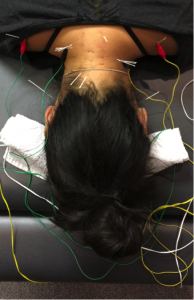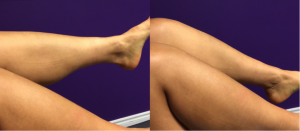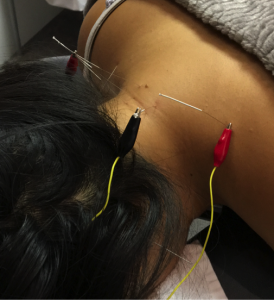The ‘point’ of Medical Acupuncture
It’s not ‘just’ a needle.
Contemporary Medical Acupuncture is a highly effective tool that integrates knowledge of pain science and neuromuscular anatomy. It involves the precise insertion of very fine solid needles into specific areas of the body, which are then stimulated manually or with electricity. Fear not! These acupuncture needles are much thinner than a needle at the doctor’s office. The goals of this Western, anatomical-based approach to acupuncture are tailored based on the individual’s movement dysfunctions and musculoskeletal pain.
These can include:
- pain reduction
- strength and power enhancement
- release of muscular and myofascial tension

The nervous system is the reason we move:
Nerves send signals to our muscles –> Muscles contract –> Movement occurs
If we can ‘tap’ into the nervous system, literally through stimulating the area around the nerve, we can optimize what the body is already intended to do.
BEFORE and AFTER with Contemporary Medical Acupuncture
Below is an example of how Contemporary Medical Acupuncture was able to improve knee joint range of motion – in just under 20 minutes!

(L) Before Acupuncture, (R) After Treatment
Medical Acupuncture versus Traditional Chinese Medicine acupuncture – what is the difference?
The approach behind Medical Acupuncture differs from the acupuncture in Traditional Chinese Medicine (TCM) in two distinct ways:
1) The intention
- Medical Acupuncture is a form of neurofunctional treatment for pain and movement dysfunction. Its aim is to modulate abnormal activity of the nervous system.
- TCM acupuncture intends to correct any imbalance or blockage of qi (energy flow), in order to achieve balance of yin and yang.
2) The targets
- Medical Acupuncture targets the peripheral nervous system (nerves outside the brain and spinal cord), muscle bellies, motor points, muscle-tendon junctions, tenoperiosteal attachments, ligaments, joints, peripheral nerve trunks and peripheral neurovascular bundles.
- TCM acupuncture targets meridians (energy channels in our body), which provide access to qi (energy flow).

Several of our practitioners have been trained through McMaster University’s Contemporary Medical Acupuncture program, in which 300 hours of Continuing Medical Education were obtained. Training covers the science, theory and research behind acupuncture and pain neurophysiology; anatomical and acupuncture point location review on real human cadaver specimens; needling workshops; and live patient case demonstrations.
As you can see, acupuncture is truly more than ‘just a needle’.
